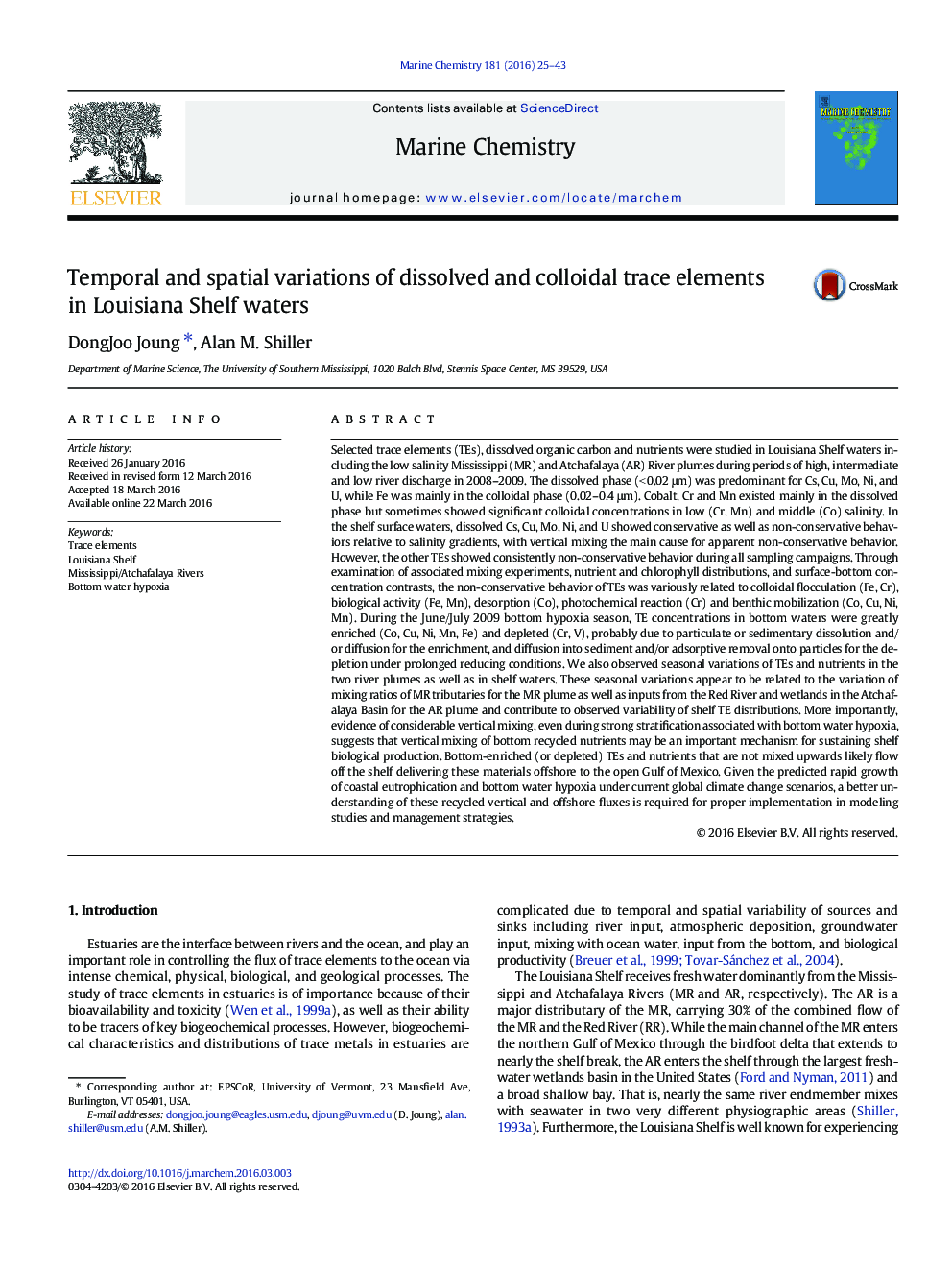| کد مقاله | کد نشریه | سال انتشار | مقاله انگلیسی | نسخه تمام متن |
|---|---|---|---|---|
| 7699162 | 1496655 | 2016 | 19 صفحه PDF | دانلود رایگان |
عنوان انگلیسی مقاله ISI
Temporal and spatial variations of dissolved and colloidal trace elements in Louisiana Shelf waters
ترجمه فارسی عنوان
تغییرات زمانی و فضایی عناصر رقیق شده و کلوئیدی در آبهای شیلویی لوئیزیانا
دانلود مقاله + سفارش ترجمه
دانلود مقاله ISI انگلیسی
رایگان برای ایرانیان
موضوعات مرتبط
مهندسی و علوم پایه
شیمی
شیمی (عمومی)
چکیده انگلیسی
Selected trace elements (TEs), dissolved organic carbon and nutrients were studied in Louisiana Shelf waters including the low salinity Mississippi (MR) and Atchafalaya (AR) River plumes during periods of high, intermediate and low river discharge in 2008-2009. The dissolved phase (< 0.02 μm) was predominant for Cs, Cu, Mo, Ni, and U, while Fe was mainly in the colloidal phase (0.02-0.4 μm). Cobalt, Cr and Mn existed mainly in the dissolved phase but sometimes showed significant colloidal concentrations in low (Cr, Mn) and middle (Co) salinity. In the shelf surface waters, dissolved Cs, Cu, Mo, Ni, and U showed conservative as well as non-conservative behaviors relative to salinity gradients, with vertical mixing the main cause for apparent non-conservative behavior. However, the other TEs showed consistently non-conservative behavior during all sampling campaigns. Through examination of associated mixing experiments, nutrient and chlorophyll distributions, and surface-bottom concentration contrasts, the non-conservative behavior of TEs was variously related to colloidal flocculation (Fe, Cr), biological activity (Fe, Mn), desorption (Co), photochemical reaction (Cr) and benthic mobilization (Co, Cu, Ni, Mn). During the June/July 2009 bottom hypoxia season, TE concentrations in bottom waters were greatly enriched (Co, Cu, Ni, Mn, Fe) and depleted (Cr, V), probably due to particulate or sedimentary dissolution and/or diffusion for the enrichment, and diffusion into sediment and/or adsorptive removal onto particles for the depletion under prolonged reducing conditions. We also observed seasonal variations of TEs and nutrients in the two river plumes as well as in shelf waters. These seasonal variations appear to be related to the variation of mixing ratios of MR tributaries for the MR plume as well as inputs from the Red River and wetlands in the Atchafalaya Basin for the AR plume and contribute to observed variability of shelf TE distributions. More importantly, evidence of considerable vertical mixing, even during strong stratification associated with bottom water hypoxia, suggests that vertical mixing of bottom recycled nutrients may be an important mechanism for sustaining shelf biological production. Bottom-enriched (or depleted) TEs and nutrients that are not mixed upwards likely flow off the shelf delivering these materials offshore to the open Gulf of Mexico. Given the predicted rapid growth of coastal eutrophication and bottom water hypoxia under current global climate change scenarios, a better understanding of these recycled vertical and offshore fluxes is required for proper implementation in modeling studies and management strategies.
ناشر
Database: Elsevier - ScienceDirect (ساینس دایرکت)
Journal: Marine Chemistry - Volume 181, 20 April 2016, Pages 25-43
Journal: Marine Chemistry - Volume 181, 20 April 2016, Pages 25-43
نویسندگان
DongJoo Joung, Alan M. Shiller,
